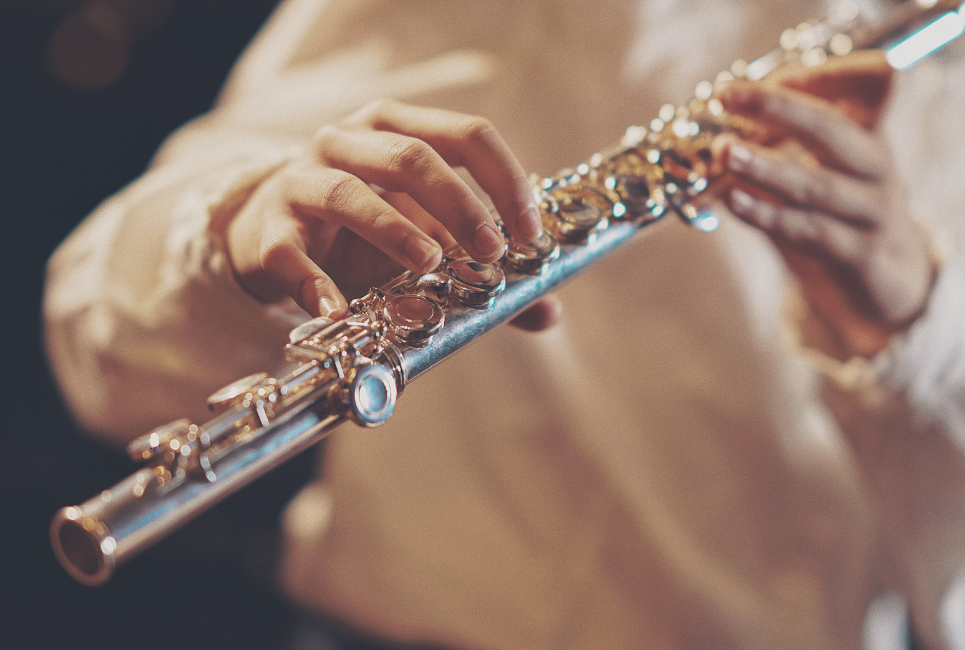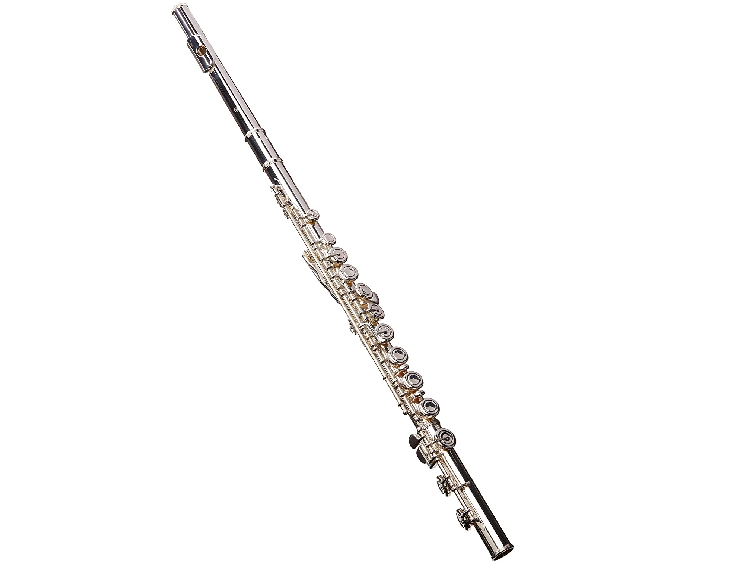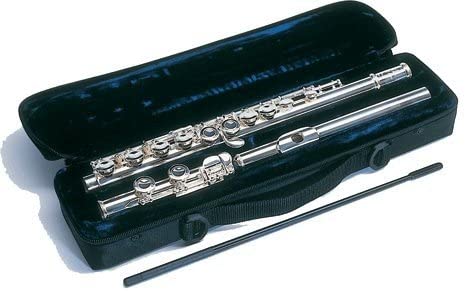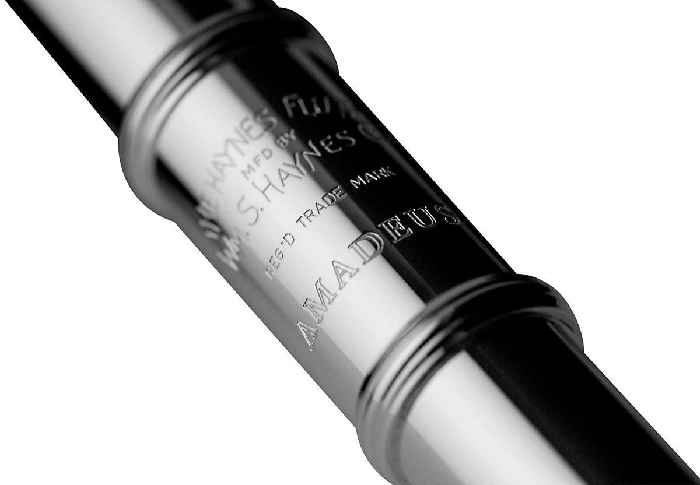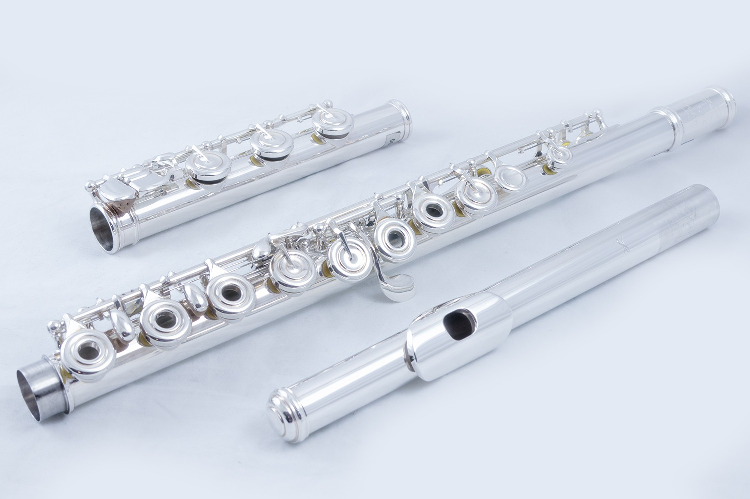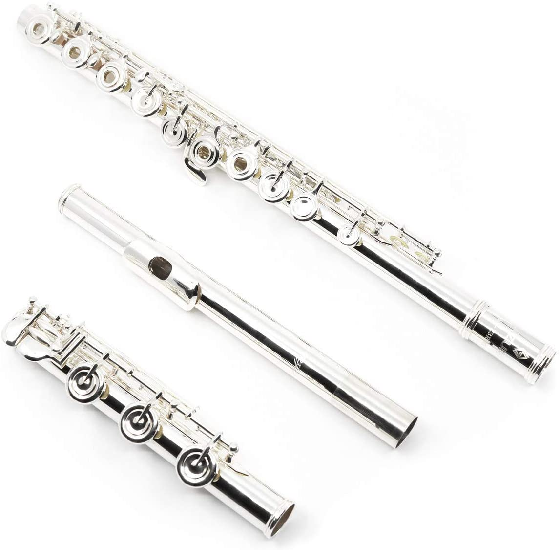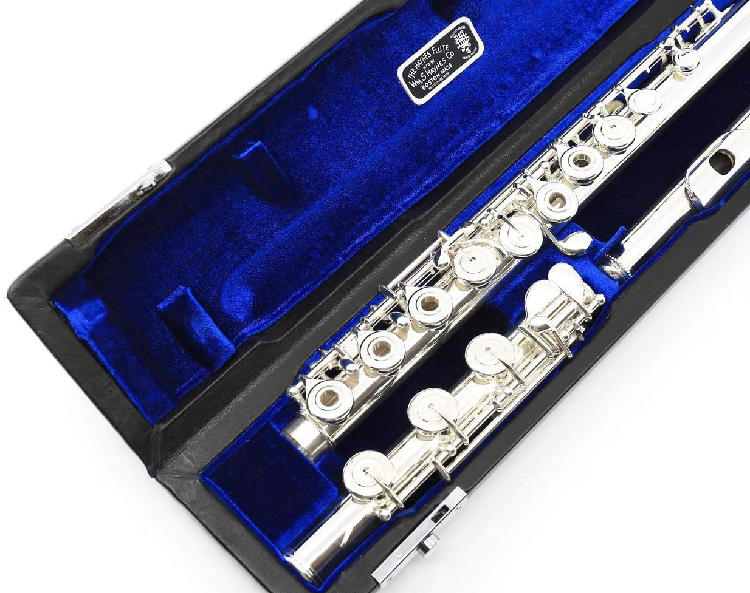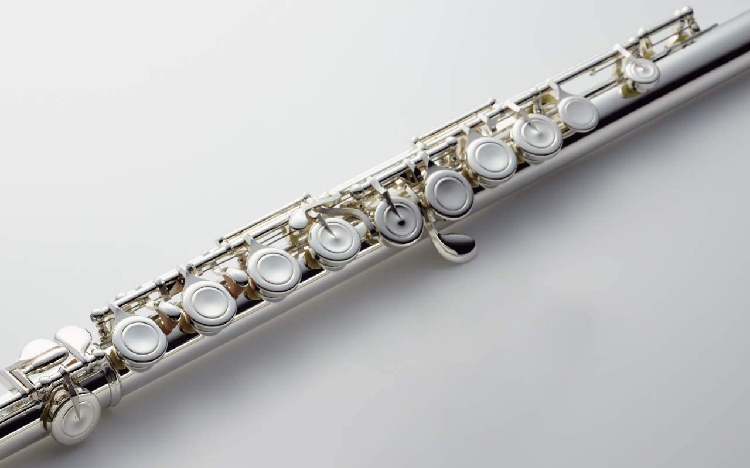- How to Find the Best Sopranino Saxophone - May 31, 2022
- How to Find the Best Contrabass Saxophone - May 30, 2022
- Trumpet Range Guide: Understanding The Entire Trumpet Range - May 19, 2022
Before you go flute shopping, you should have an idea of how much you’ll need to spend. Whether you’re new to the flute or are going to music school, consider reviewing a flute pricing guide.
Then, you can look at the cost of flutes across levels and brands. Once you have an idea of how much flutes cost, you can set a good budget and prepare for a trial.
Bottom Line Up Front: Flutes cost as little as a few hundred dollars or as much as $80,000. Look at all of the factors that affect pricing and consider some popular models to help find the flute for you.
Flute Pricing Guide
Many factors go into setting the price for a flute, so it’s important to consider what you need out of a flute. Not only that, but some flute players prefer different materials, brands, and specs.
Regardless of what type of flute you’re shopping for, you should consider what affects the price. That way, you can choose an instrument that meets your budget as well as all of your other needs.
Here are some essential parts of a flute pricing guide.
Materials
A flute’s material is one of the most significant factors that determine the price. Many beginner models use nickel with a thin layer of silver plating, and that combination is pretty affordable.
Once you reach the intermediate level, you can get flutes that are partially or completely solid silver. Professional instruments can use silver plating, solid silver, or even gold or platinum.
Some professional flutes are even made of wood, like piccolos. The specific materials of the headjoint, body, and keys can raise or lower the price of your next instrument.
Specs
The specs of a flute, aside from materials, include the keys and the embouchure hole cut. Beginner and intermediate flutes usually use one embouchure hole shape, but pro flutes come with different shapes that may cost more.
Most flutes come standard with an offset G and a low C key. Beginner models tend to have closed-hole keys, while intermediate and pro instruments have open holes, which can be more expensive.
Advanced instruments may also have a low B footjoint. Other optional specs include a split E mechanism, a C# trill key, and low D# and C# rollers, and each will drive up the price.
Some players swear by a split E mechanism or D# and C# rollers. Personally, I can’t live without a C# trill key, but other flute players hate the key, so try instruments with all specs to see what you like.
Handmaking
When you upgrade to an intermediate or professional flute, you’ll be looking at handmade instruments. Intermediate flutes tend to have handmade headjoints, while the bodies are machine-made.
Handmade instruments tend to have a better sound and are of great quality. But they can also have slight nuances, so you may need to try multiple instruments of the same model to find one that works for you.
The more handmade parts an instrument has, the more it will cost. An intermediate flute may cost $2,000, but a fully-handmade flute with the same specs could easily cost double that.
Brand
Another factor to consider is the brand itself. Some flute brands start at around $10,000 for their most basic professional model, and that doesn’t account for extra keys.
Companies like Brannen Brothers and Burkart price their flutes pretty high. The quality is amazing, so it can be worth it for the right player.
However, you may find a flute with similar specs from a different brand for closer to $6,000. Brands like Miyazawa, Pearl, and Altus have similar flutes for less than $10k.
Country
When looking at brands and prices, you may notice a trend. In general, American-made flutes tend to cost more than Japanese or European-made flutes with similar specs.
Professional Japanese flutes tend to start at around $4,000 or $5,000. Meanwhile, an American flute with the same specs can cost closer to $8,000 or $9,000.
Some players tend to do better on American or Japanese flutes, so you might luck out on the pricing. If American flutes work well for you, the extra cost will most likely be worth it.
Condition
You should also look at whether a flute you want to buy is new or used. At the student and intermediate levels, used instruments can be significantly cheaper than their new counterparts.
Now, you don’t want to buy something so cheap that it requires a lot of work to get into good condition. You might end up spending more than you would have if you bought a better model.
However, at the professional level, flutes tend to hold their value. You may be able to save a few hundred dollars, but that’s often not going to make a huge difference.
Headjoints
I briefly touched on this, but headjoints can affect the cost of a flute. For one, the specific headjoint cut may cost extra, especially if you choose something other than a traditional cut.
You also have to consider if you want to make any upgrades to the headjoint. Many companies let you change the lip plate and riser to a different material, such as gold, platinum, or wood.
Then, you can also buy a headjoint separate from a flute. Some brands, like Brannen, don’t include headjoints in the cost of a flute at all.
On the other hand, at the beginner level, you might choose a flute with a curved headjoint for a younger player. The curved shape can cost more, especially if the instrument also comes with a straight headjoint.
Level
Regardless of the other specs, flutes tend to be around the same price as others at the same level. There are some exceptions, but flutes generally have the following prices:
- Beginner: $200 to $1,000
- Intermediate: $1,000 to $3,000
- Professional: $3,000 and up
Of course, the brand, materials, and other specs can affect the price. You might also see prices outside of these ranges if you’re looking at used flutes.
If you aren’t sure if a flute is worth it, shop around. See how much other music stores or individual sellers are charging for that model to make sure you get a good deal.
Best Flutes at All Prices
Whether you’re shopping for the best beginner flute or are looking for your forever flute, you have options. I can easily think of dozens of flute brands, and all of their models combined amount to hundreds of flutes.
If you also account for different specs, the options are even more endless. Because of that, I can’t cover all of the flute brands and models, but I can share some flutes that are about average in price for their specs.
Here are some flutes you can use to start shopping for your next instrument.
Yamaha YFL-222
The Yamaha YFL-222 is probably the most popular beginner flute. It’s relatively affordable, and it’s of excellent quality so is great for beginners.
This model can withstand a lot of use, so you or your child can play it a lot before needing repairs. Like many beginner flutes, it features a silver-plated headjoint and body.
It has a low C footjoint, closed-hole keys, and an offset G key. All of that makes the instrument easy to use to get a sound out when you first start playing the flute.
Pros
- Great for beginners
- Easy to play
- Nice specs
- Affordable option
- Durable
Cons
- Beware of counterfeits
- Not for young players
Trevor James 10x
After playing on a cheap no-name flute for a while, I finally got a Trevor James 10x. This flute has all of the same specs as the Yamaha, from a C footjoint to an offset G.
If you have a young child who wants to play the flute, you can get the 10xc version. That one comes with a curved headjoint, which makes it easier for small kids to reach all of the keys.
While it’s a bit more expensive than the Yamaha, it has amazing quality. It also features an amazing case that keeps the flute from moving around as you transport your flute.
Pros
- Perfect for younger beginners
- Great quality
- Easy to play
- Nice design
- Suitable upgrade from cheaper flutes
Cons
- Not the most affordable
- Specs aren’t super unique
Haynes Amadeus AF580
A lot of intermediate flutes are from so-called “sub-brands” of professional flute companies. The Haynes Amadeus AF580 is one example since Amadeus comes from Haynes.
It features a solid silver lip plate and riser, so you can get a warm yet bright sound. Meanwhile, the rest of the model is silver-plated, which keeps the flute relatively affordable.
You’ll also get open holes to help practice where to put your fingers. The low B footjoint lets you play almost any piece of music you would need to play.
Pros
- Good upgrade
- Affordable option
- Nice sound
- Professional headjoint
- Easy to play
Cons
- Minimal solid silver
- Not for serious players
Lyric LA-1
When I upgraded to an intermediate model, I chose the Lyric LA-1. This flute features a solid silver headjoint, so you can get even more of the standard silver sound than with just a silver lip plate and riser.
It also comes with a B footjoint and open holes, and you can choose to get it with a split E mechanism. This flute got me through the second half of my bachelor’s degree in flute performance and the year after graduation.
Unlike other intermediate or step-up flutes, this one features more handmade features, but it’s still pretty affordable. Sadly, the flute did tarnish quite quickly for me, but you may not have that problem.
Pros
- More specs available
- Handmade
- Good for serious players
- Easy to play
- Good value
Cons
- Can tarnish easily
- Hard to find
Azumi AZ3
Another intermediate flute to consider is the Azumi AZ3. Similar to Haynes Amadeus, Azumi is a sub-brand of the professional flute company Altus, so this flute comes with a pro Altus headjoint.
The entire headjoint and body are solid silver, so you can get a great sound. You also have the option of specs such as a split E mechanism and a C# trill key.
Open holes and a B footjoint are standard as well as an offset G key. While this model is more expensive due to the extra silver content, it’s still a good deal for the serious student.
Pros
- More silver content
- Great for advanced players
- Extra specs available
- Easy to play
- Nice sound
Cons
- Slightly expensive
- Not for every advanced player
Yamaha 777
When you’re ready for a professional flute, the Yamaha 777 is an excellent model to try. This flute may work for you if you’ve played student and intermediate Yamahas.
It’s a handmade instrument with a solid silver headjoint, body, and mechanism. You’ll get Straubinger pads, which are common among professional flutes.
At this level, you can opt for a flute with a split E mechanism and/or a C# trill key. If you want an inline G key, you’ll want to look at the 787, which has similar specs and a similar price.
Pros
- Good for Yamaha players
- Easy to play
- Full silver
- Handmade
- Professional pads
Cons
- Not the most professional
- Inline G is a different model
Haynes Q2
The Haynes Q2 is one of the more affordable professional flutes from the company. It comes in all sterling silver, and you’ll get a hand-cut headjoint.
An offset G key, split E mechanism, and C# trill key all come standard on the flute. If you’ve played an Amadeus and liked it, a Haynes flute is a straightforward upgrade.
Compared to some brands with the same specs, this flute is pretty affordable. It’s a nice choice for professionals and serious amateur players who want the best of the best.
Pros
- Affordable for the level
- Good specs
- Nice sound
- Easy to play
- Perfect upgrade
Cons
- A bit bright
- Not for all players
Pearl Cantabile
Another professional flute I had to include is the flute I own and play. I bought the Pearl Cantabile after trying a few other pro models at a National Flute Association Convention.
The standard Cantabile is sterling silver, but I got it with complete rose gold plating to get a warmer tone. I also got a C# trill key, open holes, an offset G, and a B footjoint.
This flute comes with four headjoint cut options, from more circular to more square. The base price is pretty reasonable, and the C# trill, split E, rollers, plating, and engraving are available for an extra cost.
Pros
- Plenty of customizations
- Handmade model
- Easy to play
- Warm tone
- Good intonation
Cons
- Customizations can be expensive
- Not for everyone
FAQs About the Flute Pricing Guide
Answer: Most flutes you’ll come across are $20,000 are less, and most of those don’t cost more than $10,000. But you can find a couple of flutes that cost over $80,000.
Flutes at that price tend to use platinum and gold as the main materials. Luckily, you can keep prices low by sticking to silver or lower karat gold, such as 10 karats.
Answer: The easiest way to save money on a flute is to buy it used. Most people looking to sell a flute will drop the price compared to what they paid when they bought the flute new.
When I bought my professional flute, I lucked out and bought it on clearance. I purchased it directly from the manufacturer, so you might be able to save on the wholesale markup that you’d find at a music store.
Answer: Financing a flute can be an excellent way to get the flute you need and pay it off later. Most music stores offer some sort of financing program to help you cover the cost.
Another option is to get a personal loan and pay off the loan. If you’re in school, you may be able to petition your school to raise your cost of attendance. That way, you can get student loans to pay for a flute.
Answer: The amount you should spend on a flute depends on your goals. For your first flute, I’d recommend spending less than $1,000, but you can up that to $2,500 for an intermediate model.
At the professional level, you have to consider the brand, materials, and specs you want. For example, if you want a solid gold flute, you’ll have to spend more than someone who wants a sterling silver model.
Final Note on the Flute Pricing Guide
When shopping for a new instrument, you should consult a flute pricing guide. For better or worse, flutes come at all price points, from less than $1,000 to over $80,000.
While I love my Pearl Cantabile, that flute may not work for you. It’s up to you to compare flutes and prices to find what works for you.
Be sure to consider your level to narrow your flute search. Then, you can look for a flute that suits your needs and budget, so you can improve your playing.

